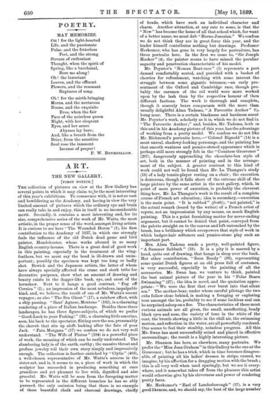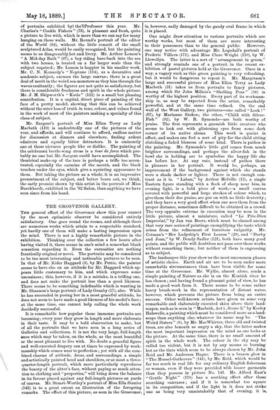ART.
THE NEW GALLERY.
[FIRST NOTICE.]
THE collection of pictures on view at the New Gallery has several points in which it may claim to.be the most interesting of this year's exhibitions. To commence with, it is not so vast and bewildering as the Academy, and having in view the very limited amount of pictures which the ordinary eye and brain can really take in and enjoy, this in itself is no inconsiderable merit. Secondly, it contains a most interesting and, for its size, comprehensive series of the work of Mr. Watts, the most artistic, in the proper sense of the word, amongst living artists. It is curious to see here "The Wounded Heron" (1), his first contribution to the Academy of 1837, in which one strongly feels the influence of the old Dutch dead game and bird painter, Hondekooter, whose works abound in so many English country-houses. There is a great deal of good work in this painting, especially in the treatment of the wing- feathers, but we must say the head is ill-drawn and unim- portant; possibly the specimen was kept too long or badly shot. Bewick and the Japanese artists, the latter of whom have always specially affected the crane and stork tribe for decorative purposes, show what an amount of drawing and beauty exists in the dagger-like beak, eye, and crest of the hernshaw. Next to it hangs a good contrast, "Fog off Corsica" (2) ; an impression of the most nebulous, impalpable kind, and, we believe, the result of one of Mr. Watts's recent voyages ; as also "The Sea Ghost" (17), a rainbow effect, with a ship passing. "Sant' Agnese, Mentone " (162), is a charming rendering of a piece of Italian landscape. Besides these three landscapes, he has three figure-subjects, of which we prefer "Good-Luck to your Fishing!" (33), a charming little amorino, seen, his back to the spectator, flitting over the sea, presumably the cherub that sits up aloft looking after the fate of poor Jack. " Fata Morgana " (57) we confess we do not very well understand. "The Wife of Plutus " (184) is a powerful piece of work, the meaning of which can be easily understood. The slumbering lady is of the earth, earthy; the massive throat and profuse jewelry tell their own story simply and impressively enough. The collection is further enriched by " Clytie" (403), a well-chosen representative of Mr. Watts's success in the sister-art, and is, it seems to us, a piece of work in which the sculptor has succeeded in producing something at once grandiose and yet pleasant to live with, dignified and also graceful. Mr. Watts will be seen from the foregoing matter to be represented in the different branches he has so ably pursued, the only omission being that there is no example of those beautiful chalk and charcoal drawings, chiefly
of heads, which have such an individual character and charm. Another attraction, at any rate to some, is that the " New " has become the home of all that school which, for want of a better name, we must dub "Burne-Jonesian." We confess we do not think they are in great force this year, and the leader himself contributes nothing but drawings. Professor Herkomer, who has gone in very largely for portraiture, has three portraits here. In the first we come to, "Sir Joseph Hooker" (4), the painter seems to have missed the peculiar sagacity and penetration characteristic of his model.
Mr. Poynter's "Roman Boat-race" (5) represents a pert damsel comfortably seated, and provided with a basket of cherries for refreshment, watching with some interest the struggle between some gigantic triremes,—an early pre- sentment of the Oxford and Cambridge race, though pro- bably the oarsmen of the old world were more worked upon by the lash than by the respective honour of then different factions. The werk is thorough and complete, though it scarcely bears comparison with the more than, usually delightful Alma Tadema, "A Favourite Author" 8), huug near. There is a certain blackness and hardness about Mr. Poynter's work, scholarly as it is, which we do not find in "The Favourite Author ;" and, besides, Mr. Tadema, both in this and in his Academy picture of this year, has the advantage of working from a pretty model. We confess we do not like Mr. Richmond's portraits here,—" Colonel Bignold" (14) is a. most unreal, shadowy-looking personage, and the painting has that smooth waxiness and pumice-stoned appearance which is perhaps still more strongly felt in the "Countess Grosvenor" (207), dangerously approaching the chocolate-box style of art, both in the manner of painting and in the arrange- ment of the subject. A greater contrast to this kind of work could not well be found than Mr. La Thangue's study (16) of a lady tennis-player resting on a chair ; the execution_ is dexterous, though it falls short of the extreme skill of the large picture by the same artist in the next gallery, which, in point of mere power of execution, is probably the cleverest thing here. Mr. La Thangue's work is the result of a complete course of French art education ; idea is secondary,—execution is the main point. "It is rubbed' (frottO, "not painted," is the actual remark (beard by the writer) of a French artist of repute, not an impressionist by any means, on much English painting. This is a point furnishing matter for never-ending argument, but it cannot be denied that paint, conveyed from the palette straight on to the canvas and left untouched by the brash, has a brilliancy which overpowers that style of work in which badger-hair softeners and pumice-stone play such an important part.
Mrs. Alma Tadema sends a pretty, well-painted figure, "A Summer Sabbath" (19). It is a pity it is marred by a hand, quite out of drawing, that hangs in sleep over the book..
Her other contribution, "Soon Ready" (98), representing some quaint Dutch figures at an old press full of costumes, is very successful, especially in the painting of all the accessories. Mr. Swan has, we venture to think, painted. the best animal picture of the year in his "Polar Bears Swimming" (27) ; the idea is novel, and the quotation appro- priate: "We were the first that ever burst into that silent sea." The mother-bear, under whose careful pilotage the two' cubs follow close behind, is making a foraging or exploring tour amongst the ice, probably to see if some luckless seal can be surprised asleep on a floe. The characteristics of these most, curious animals are all given, the small, unreflecting, beady black eyes and nose, the variety of tone in the white of the coat, the breath showing a little in the chill air, the swimming motion, and reflection in the water, are all powerfully rendered. One seems to feel their stealthy, noiseless progress. All this. Mr. Swan has most successfully seized and placed in effective surroundings ; the result is a highly interesting picture.
Mr. Shannon has here, as elsewhere, many portraits. We prefer the "Miss Jean Graham" in this Gallery to the one at the Grosvenor; but he has a trick, which in time becomes disagree- able, of painting all his ladies' dresses in strips, caused, we imagine, by his affection for a dragging motion with the brush ; this is all very well when used sparingly, but we see it every- where, and it somewhat takes off from the pleasure this artist would otherwise give by his cleverness and power of rendering pretty faces.
Mr. Herkomer's "Earl of Londesborough " (57), is a very good likeness, and, we should say, the best of the large number
of portraits exhibited by] thaProfessor this year. Mr. Charles's "Cockle Fishers" (73), is pleasant and fresh, quite a picture to live with, which is more than we can say for many hanging on these walls. Mr. Round's portrait of the editor of the World (84), without the little conceit of the small sculptured Atlas, would be easily recognised, but the painting seems to us disagreeably,hot and livery. Mr. Arthur Lemon's "A Mid-day Bath" (97), a boy riding bare-back into the sea with two horses, is treated on a far larger scale than the subject required ; Mr. Lemon is happier in his smaller work. Mr. C. N. Kennedy's "Neptune (114), as a decorative and academic subject, excuses the large canvas ; there is a great deal of merit in the weird sea-monsters as they hiss through the waves exultantly ; the figures are not quite so satisfactory, but there is considerable freshness and spirit in the whole picture. Mr. J. M. Skipworth's " Katie " (122) is a small but pleasing eontribution. It is a capital, direct piece of painting of the face of a pretty model, showing that this can be achieved without the utter loss of truth in tone, colour, and values found in the work of most of the painters making a specialty of this class of subject.
Mr. Sargent's portrait of Miss Ellen Terry as Lady Macbeth (110) is undoubtedly one of the pictures of the year, and affords, and will continue to afford, endless matter for discussion at dinners and elsewhere, finding ardent admirers and equally bitter detractors. It is eminently one of those pictures people like or dislike. The painting of the celebrated beetle-wing dress is a tour de force which pro- bably no one but Mr. Sargent could have accomplished. The theatrical make-up of the face is perhaps a trifle too accen- tuated, especially the carmine of the mouth, and the black touches under the eyes, which give a squinting appearance to them. But taking the picture as a whole, it is an impressive presentment of the subject, and better bears out, we think, the early promise shown by this artist in the portrait of Miss Burckhardt, exhibited in the '82 Salon, than anything we have seen since from his hand.



































 Previous page
Previous page